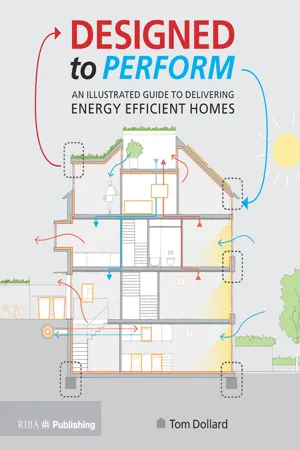
- 144 pages
- English
- ePUB (mobile friendly)
- Available on iOS & Android
About this book
This book is an illustrated practical design guide to delivering better energy performance in all types of new build homes. It takes the form of an annotated details book, with photos taken from live construction sites, with the content based around diagrams, drawings and photos by the author, which demonstrates valuable best practice knowledge and advice.
Chapter 1 is an introduction to the performance gap and the quality of design and construction in new build homes, explaining the typical construction sequence of homebuilding, and highlights common issues that designers need to engage with. Chapters 2-7 look at each construction fabric in turn, including a series of detailed drawings, diagrams and photos illustrating the key elements of good design. Chapter 8 contains a checklist of all performance gap issues that designers need to look for.
This book will provide valuable guidance to architects and designers on how to improve their detailing at construction stage, and therefore the overall quality of design and performance of new homes.
Frequently asked questions
- Essential is ideal for learners and professionals who enjoy exploring a wide range of subjects. Access the Essential Library with 800,000+ trusted titles and best-sellers across business, personal growth, and the humanities. Includes unlimited reading time and Standard Read Aloud voice.
- Complete: Perfect for advanced learners and researchers needing full, unrestricted access. Unlock 1.4M+ books across hundreds of subjects, including academic and specialized titles. The Complete Plan also includes advanced features like Premium Read Aloud and Research Assistant.
Please note we cannot support devices running on iOS 13 and Android 7 or earlier. Learn more about using the app.
Information
Chapter 1:
The performance gap and how to reduce it
What is the performance gap?
Why is it important?
What can we do about it?
- Lack of understanding, knowledge and skills
- Unclear allocation of responsibility
- Inadequate communication of information
What can policy makers do?
- Streamline, simplify and improve compliance with Approved Document Part L, to include a simple but comprehensive as-built performance check. This will include increased building control presence on site to check energy performance and associated construction quality. Award good practice in this area with incentives such the NHBC Pride in the Job Awards.
- Make a construction guidance web resource available to all, to share and improve levels of construction. Include helpful tips, user videos and guidance on design and installation. To include standard details and installation sequencing.
- Improve energy literacy: Training design and site teams in energy efficiency and correct installation of fabric and services to be included in standard training and qualification routes.
What can the designer do?
- Design a simple and compact building envelope, with minimal external surface area, reduced complexity of detailing, continuous insulation and airtightness.
- Reduce thermal bridging by following design guidance and carrying out bespoke modelling.
- Specify simple building services that perform as intended and are easy to operate and maintain.
- Ensure drawings and specifications are clear and consider construction sequencing, buildability and as-built performance.
- Ensure project team has the skills and experience to identify and deliver an efficient solution. Invest in training and seek expert guidance on energy analysis to improve performance.
What can the contractor do?
- Improve quality assurance on site with finishing foreman role on large sites, extra building control visits and a clerk of works to inspect quality.
- Increase role and responsibility of designer on site, with better communication between designer and site team. Ensure design continuity by appointing the design team through to construction stage.
- Nominate one of the project team to be ‘energy champion’ on site, to be responsible for as-built energy performance. The role encompasses airtightness, windtightness, continuous insulation, correct building services and commissioning check.
- Install correct products according to specification and SAP.
- Ensure the building services are thoroughly commissioned, especially ventilation, and provide information and training to residents on use and maintenance.
- Ensure subcontractors have suitable training and experience for their job, e.g. BPEC in ventilation. Carry out toolbox talks to emphasise airtightness, thermal bridges and building services commissioning.
It's about quality, not just energy
Improved quality inspection on site
Chapter 2:
How to detail a thermally efficient building envelope
Three layers
Table of contents
- Cover
- Title
- Copyright
- Contents
- How to use this book
- Glossary
- Introduction
- 1. The performance gap and how to reduce it
- 2. How to detail a thermally efficient building envelope
- 3. Masonry - cavity wall construction
- 4. Concrete frame construction
- 5. Timber frame construction
- 6. Insulated concrete formwork
- 7. Off-site construction
- 8. Building services performance
- 9. How to deliver improved performance
- Appendices
- Further Reading
- Endnotes
- Image Credits